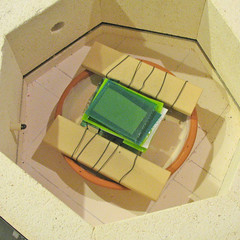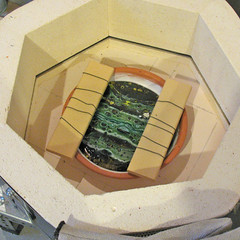A mesh melt, or pot melt is where several layers of glass are melted through wire to form an abstract glass pattern.

In this instance I started with a stack of clear and opaque green glass with a couple of pieces of white. The glass stack is about 2.5 cm high, but it's more important that I have enough glass to form an even layer of melted glass at the bottom.

The glass is stacked on a heat tolerant wire mesh with a large plant pot tray underneath. The tray is nothing special, I got this one from home Depot this weekend :-) The wire I use can withstand temperatures of 2200 degrees F. The wire is not galvanized as high temperatures will produce noxious and potentially dangerous (lethal) gases. The pot tray has been treated with a clay solution so that the melted glass will not stick to it.

Nine hours later after reaching 1700 degrees F (925 Celsius) the glass has melted through the wire mesh to form one disk of glass. If there's one thing I have learned with pot melts is that the glass has to be annealed properly and left to cool very, very slowly. When I'm fusing small glass pieces I sometimes vent my kiln when the temperature gets below 500 degrees F, but with a pot melt that can cause the glass to crack. So with pot melts I don't open the kiln until the internal kiln temperature has dropped below 200 degrees F.
The pattern depends on the glass wire placement, the glass used and the order in which the glass is stacked.

The glass can be cut and used for jewelry or kept in one piece and slumped on to a plate or bowl form. I will probably grind the edges of this piece to make a smooth, more regular circle and place it back into the kiln for a fire polish before slumping over a small bowl.
12 comments:
Gorgeous. I'm a glass art student and I am going to do my first pot melt soon. I am making a brick, which will be cut into strips, which will in turn be fused into a flat panel for a square slump. my next one will be used as a roll up in the hotshop to be furnace blown into a vase. I'll let ya know what happens as it goes :)
That is a beautiful piece of glass.
I've been researching on doing my first pot melt and this was very helpful - Can't wait to try it out!
Thanks,
Deb DiSalvo:)
http://www.artisticflair.etsy.com
very interesting, i am always experimenting with new ideas.will definitely try a pot melt soon.
This piece of glass is beautiful ... where do you get the heat resistant wire mesh? My daughter has fallen in love with pot melts and I'm sure she will want to try this ... please let me know ... thanks ...
What kind of wire, and where do you get it? I'm wanting a thin wire to use for whiskers in a lion sculpture that can withstand firing to cone 6.
This is an incredible melt. Did you use bubble powder to get that effect or did it just happen that way? I have to rent time on a kiln so I'm) trying to learn as much as possible before hand. Experimentation is pricey when you don't own tools.
I love that this one looks so much like impressionist art!
Hi love this plate!!!
As I am new to this would you be so kind to share the firing schedule use? What kind of glass did you use as there seems to be chemical reaction to get the amber tone...is this bullseye???
Merci
A wonderfull nice piece of glass. I have to make something myself now!!!-(soon.) Can't wait. Let you know if it is succesfull. Marianne de Liefde (the Netherlands)
How do you keep metal residual from being in the glass ?
What is the treatment to the clay? Kiln wash?
Thanks
Jeff
How do you keep metal residual from being in the glass ?
What is the treatment to the clay? Kiln wash?
Thanks
Jeff
I am new to glass firing. What type of wire is used? I noticed you said no galvanized.
Post a Comment